MARIANI’S
January
2,
2011
NEWSLETTER
Click Here to return to John Mariani's Homepage
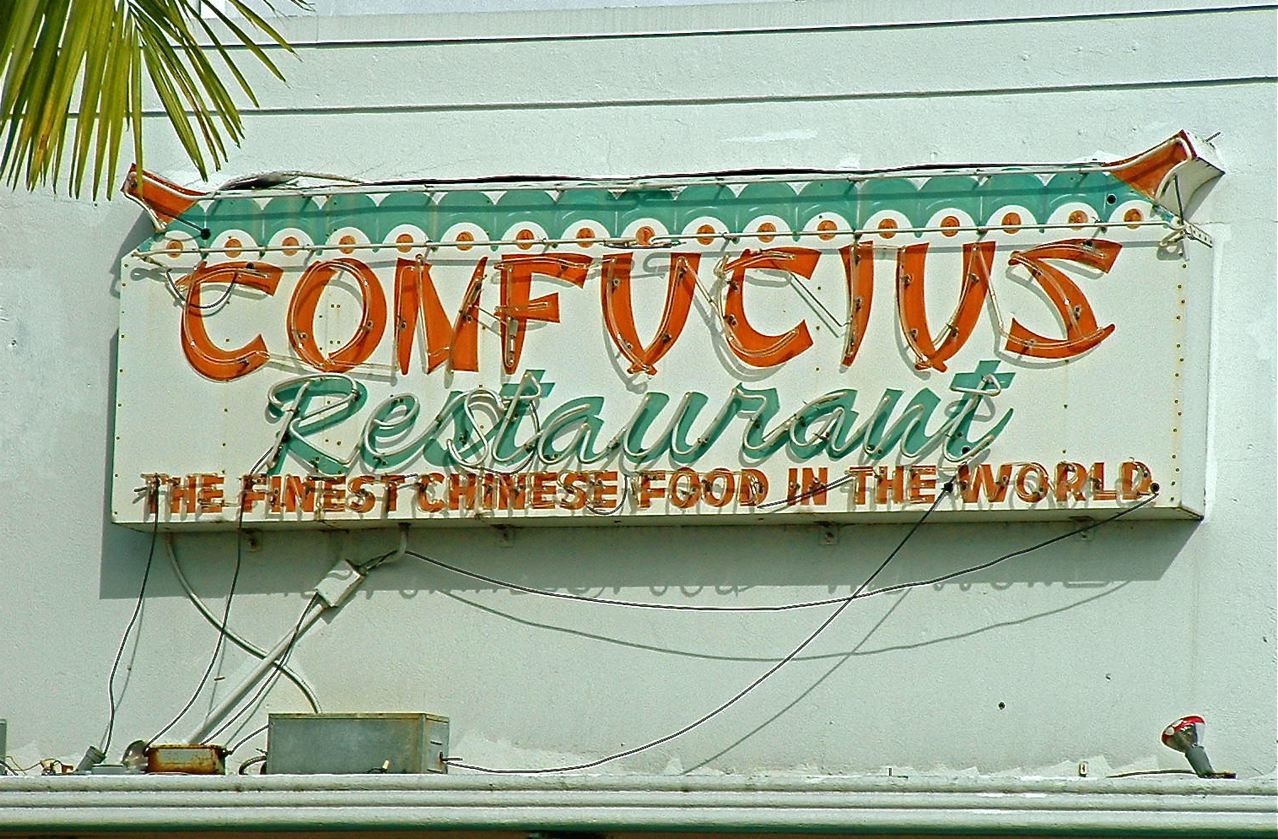
Georgia's Burger Wars
by Suzanne Wright
New York Corner: Benoit
by John Mariani
Man About Town: Benjamin Steak House White Plains
by Christopher Mariani
Wine: Argentine Adventure
by Brian Freedman
Quick Bytes
THE BEST RESTAURANT CITIES IN THE USA
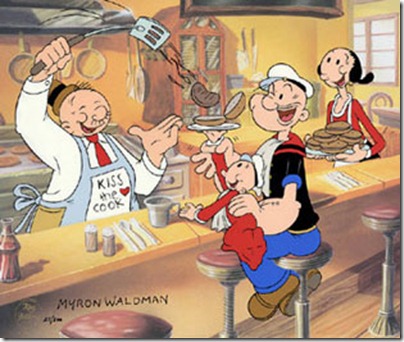 GEORGIA'S
BURGER WARS
GEORGIA'S
BURGER WARS
By Suzanne Wright
You’d
be hard-pressed to find a more
perfect melding of concept and neighborhood
than Farm
Burger
in
Decatur, GA. A hit since its April
opening, it’s the
antithesis of another new burger place in Atlanta,
Richard Blais’s self
conscious FLIP.
As
suggested by the name,
Farm Burger features a sustainable menu,
including local grass-fed beef.
FB (right)
is kid-friendly and the interior is
appealingly bare bones: whitewashed brick walls,
picnic tables topped
with a
roll of paper towels, condiments and silverware, brown
paper placemats
stamped
with a cow, self-serve iced tea.
The beer
list includes Pigslap and Miller High Life (also
used to batter
the onion rings), but I opted for a delicious adult
float made with JK
Scrumpy’s cider. Among
the
starters are $3 fried chicken livers served with a
grainy mustard
vinegar,
seasonal pickles (daikon, cauliflower, carrots and
cucumbers on my
visit) and bright
purple eggs pickled in beet juice and served in a
glass jar. Sadly,
they were sold
out of beef marrow the day of my visit.
You can build your own burger or
opt for
the “blackboard” burgers. My
only
“beefs” here are that the
kitchen
takes a temperature on your burger, then fails to
deliver on it (mine
were both
slightly overcooked and a tad greasy) and the buns,
from Masada Bakery,
are a
bit insipid. My favorite
burgers
were the Foodie, a patty topped with braised pork
belly, onion rings
and
pickled jalapeños (sherry-date BBQ sauce adds a
sweet-piquant
note), and the
No. 6, with a sunny side up egg, house-cured bacon, salsa verde and
pepper jack
cheese. There’s also a veggie quinoa burger, and a
vegan burger is
under
development. The fries
(sadly,
limp) and excellent onion rings are served with smoked
paprika mayo, an excessive
flourish but its
exuberance is likable. Word to the wise:
avoid
prime-time
hours
unless
you
relish
waiting
in
a
line
that
snakes
out
the
door
and down the sidewalk.
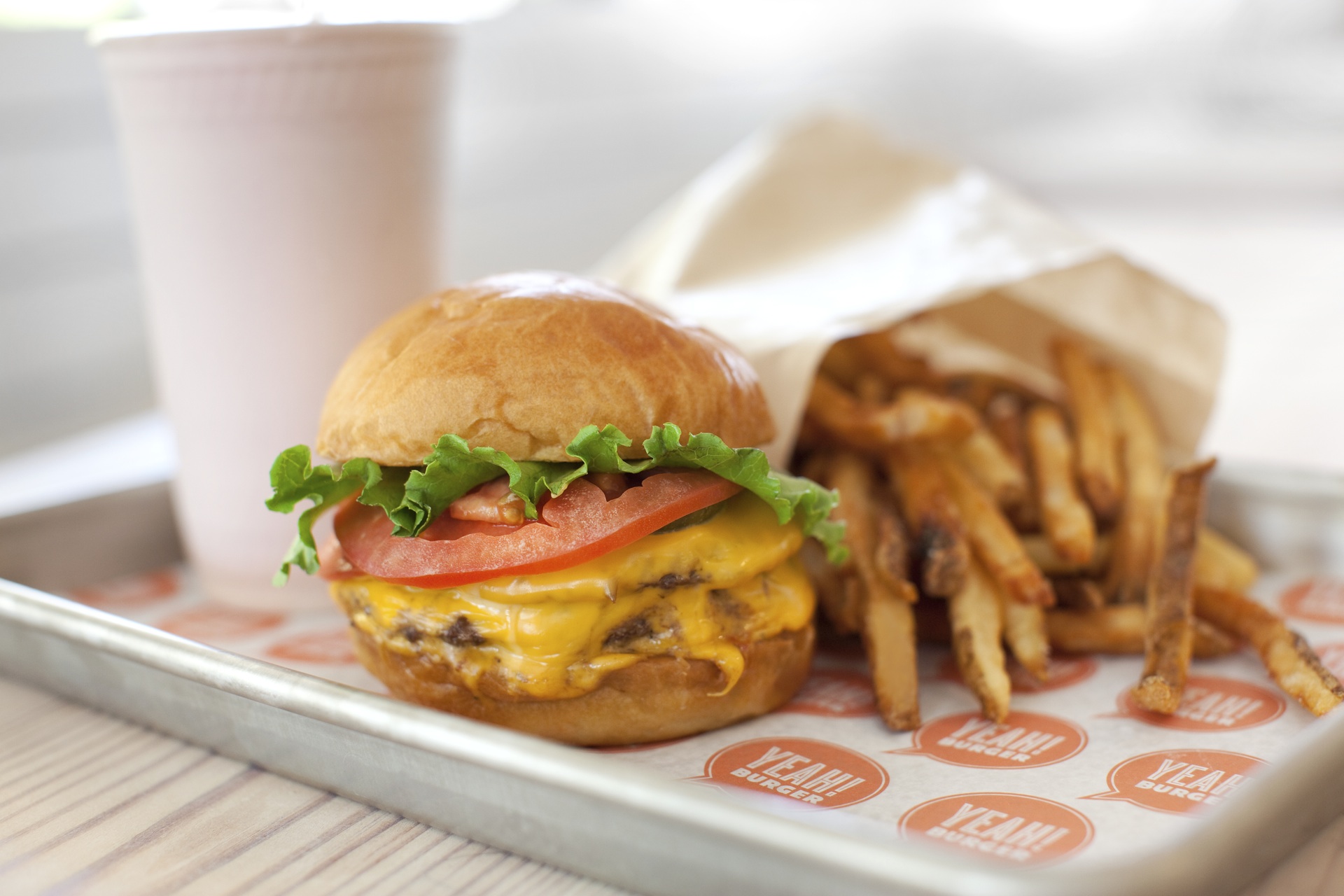 I
found the burgers at Yeah!
Burger, in Westside (the
town’s of-the-moment
dining
destination) more straightforward and, ultimately,
satisfying than
those at
Farm Burger; I’d add that the overall vibe is more
whimsical and less
earnest. Seasoned pro
Sean Doty
(Sean’s in Inman Park) owns YB, open since June. Business
has
been
booming.
The
crew
seemed
tired
but
happy;
franchising
is
already
being
discussed.
I
found the burgers at Yeah!
Burger, in Westside (the
town’s of-the-moment
dining
destination) more straightforward and, ultimately,
satisfying than
those at
Farm Burger; I’d add that the overall vibe is more
whimsical and less
earnest. Seasoned pro
Sean Doty
(Sean’s in Inman Park) owns YB, open since June. Business
has
been
booming.
The
crew
seemed
tired
but
happy;
franchising
is
already
being
discussed.
I
saw
fewer
kids
here
than
at
Farm
Burger and more
workers from the nearby industrial parks and hipsters
from the ‘hood.
With
exposed ductwork and stainless steel stools, the room
has a loft-like
feel. The huge
patio is welcome when the weather turns warmer.
All burgers (above)
are
cooked
medium,
a
smart
decision
in
such
a
bustling
place
(takeout
is
also
available). Notably,
YB
succeeds in two categories I usually dismiss: turkey
and veggie burgers. I’ve
never eaten a turkey burger like this
one, though--juicy and
well-seasoned with the
surprise of tarragon; unlike most sawdust-tasting
concoctions, the
veggie, made
with organic sea island peas, was inspired and
texturally pleasant.
Though a
confirmed carnivore, I would order both again. Buns,
from
Holeman
&
Finch
(Linton
Hopkins’
bakery),
are
divine,
combining
the
right
ratio
of
fluff to compression. I adored the
double
stack grass-fed beef burger topped with a fried egg,
turkey bacon and
pimento
cheese, and I was blown away by the Southern (beef)
hot dog with hot
Alabama
relish and grilled Vidalia onions.
Be sure
and order the bacon jam, a smoky-sweet smear that
transforms
every burger.
Among sides, the Napa coleslaw made
with
soy mayo, mint and cabbage was tasty, light and
refreshing. My only
quibble is
that French fries, in comparison to the stellar
Vidalia onion rings,
were a bit
forgettable. If you’ve
got room
for dessert, try the black cow —cherry soda and
vanilla ice cream—or a
"concrete," vanilla soft serve ice cream with mix-ins
like house-made
almond
bark.
Todd
Ginsberg’s
Bocado
is
just down the road from Yeah! Burger and shares a
similar design
aesthetic. The
ingredients-driven
menu shines in the small plates.
"Chicken
liver goodness" (you read that right) is based on
Todd's mom’s
recipe and unlike any other I’ve had: chunky
liver mounded on
bacon onion
toast. The genius touch? The sweetness of applesauce
for
balance. And it’s a real
bargain
at $6. Sugar snap peas
with
whipped ricotta were lively in the 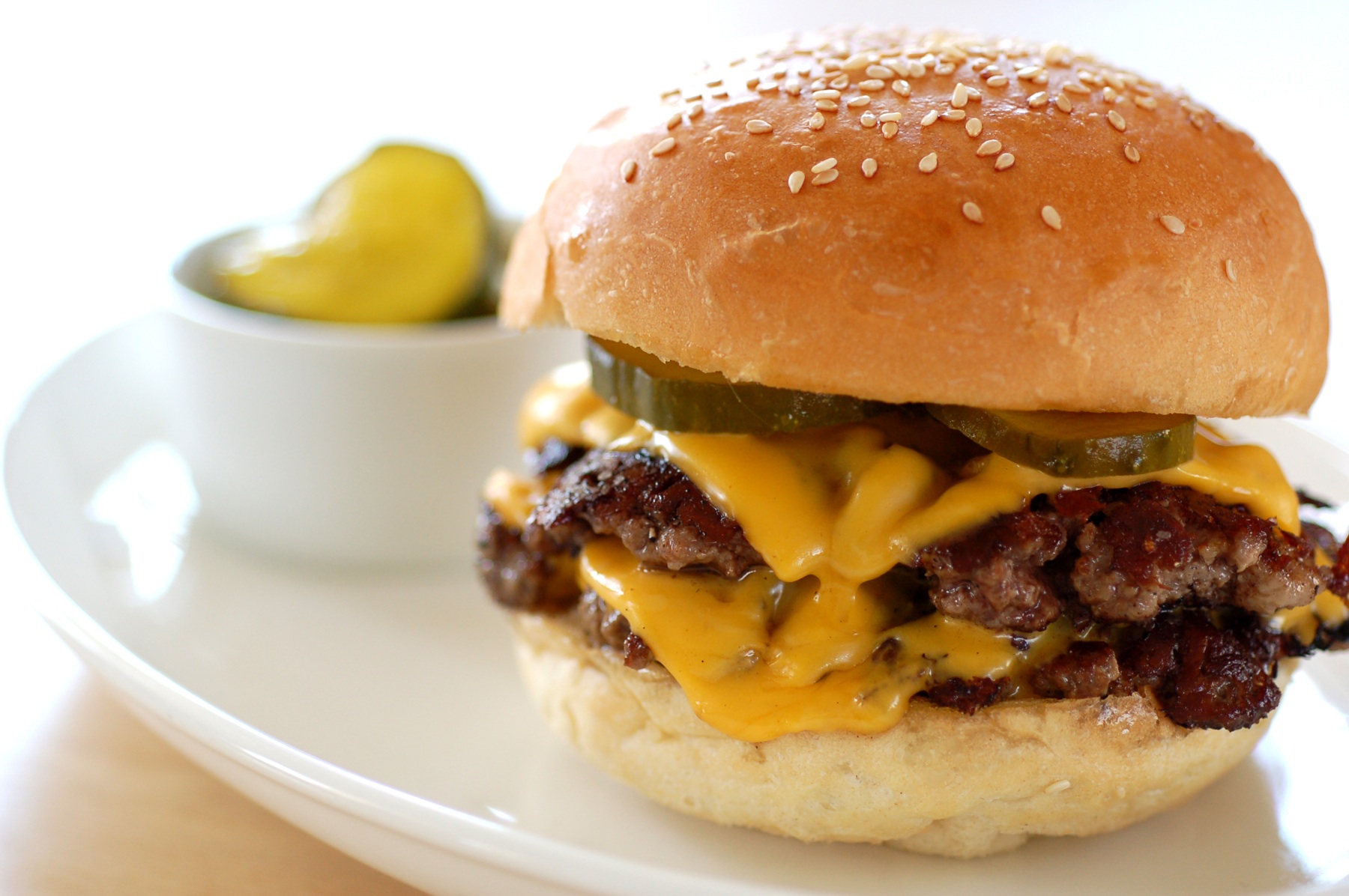 dish
and
on
the
tongue
(a
dash
of
salt
would
further
amp
the
flavor)
though
dearly priced at $11. Ginsburg’s deviled
eggs
are elegant and benefit from the acidity of pickled
red pearl onions
and
saltiness of prosciutto. The
wonderfully
light and silky chilled corn bisque with Georgia
shrimp was
ideal
on a hot night, the dice of chives and arugula
providing a bright note.
Only
Georgia peaches with pistachio and arugula pesto,
local blueberries and
duck
prosciutto felt a bit one-note. Though
each
element was in peak form, the combination
lacked sharpness.
dish
and
on
the
tongue
(a
dash
of
salt
would
further
amp
the
flavor)
though
dearly priced at $11. Ginsburg’s deviled
eggs
are elegant and benefit from the acidity of pickled
red pearl onions
and
saltiness of prosciutto. The
wonderfully
light and silky chilled corn bisque with Georgia
shrimp was
ideal
on a hot night, the dice of chives and arugula
providing a bright note.
Only
Georgia peaches with pistachio and arugula pesto,
local blueberries and
duck
prosciutto felt a bit one-note. Though
each
element was in peak form, the combination
lacked sharpness.
Among the mains, the burger with
house-made pickles (left)
is a good choice, but the
flounder,
served with zucchini succotash, while perfectly
cooked, faded from
memory with
every bite. I had high
hopes for
the roasted poblano, pimento cheese, bacon and fried
green tomato
sandwich, but
it didn’t live up to its promise:
it
arrived a lukewarm, sloppy mess, though the
accompanying warm tomato
bisque was terrific. The
kitchen
rebounded with dessert, in particular, the blueberry
Betty. With a
slightly dry
texture (in a good way), it was not too syrupy or
sweet. And while I wish
the bittersweet
chocolate pudding with caramel whipped cream was
served in a parfait
glass—the
Mason jar is too folksy and tough to navigate without
a long-handled
spoon—I
confess I gobbled up every bite, finding the surprise
of bananas at the
bottom.
Suzanne Wright is a
writer living in
Atlanta and founder of www.writesquared.com.
BY JOHN MARIANI
photos by Mike Piazza
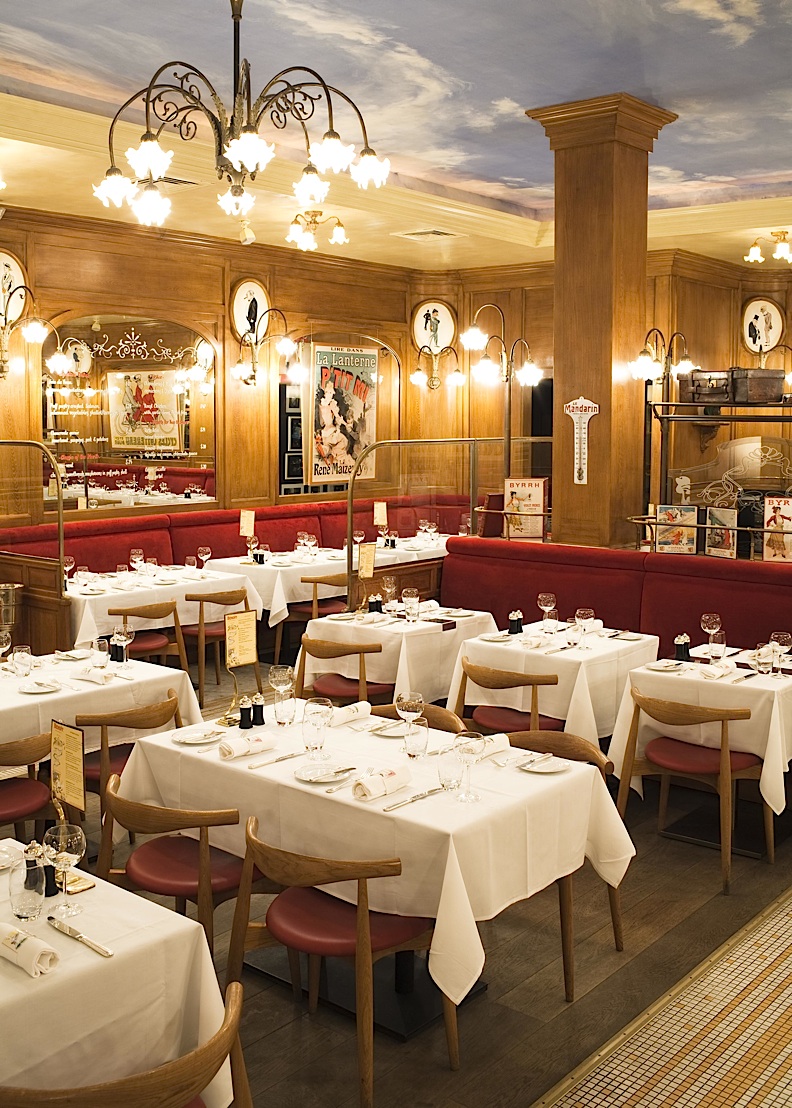 Benoit
Benoit60 West 55th Street
646-943-7373
From
a wine
red banquette at
Benoit I watched as two young French women at another
table, their
scarves
artfully tied, sipped Sancerre and nibbled on gougères.
One
of
them
tapped
the
crust
of
a cassoulet
with a spoon to release its
steamy aroma. They gobbled up the hot frites
with abandon, then ordered a baba au
rhum for dessert, all the time
leaning in
towards each other to gossip and giggle.
Such
a
scene
would
be
wholly
unremarkable
at
Benoit
in
Paris,
which
opened
on
the
Rue
Saint-Martin
back
in
1912, but this was in New York, where global
restaurateur Alain
Ducasse, who also owns the Paris original,
opened an
evocative branch of Benoit on the premises that had
once been the
legendary La
Côte Basque. When Benoit NY opened in the spring
of
2008, the enterprise was received with
thunderous
yawns by the New York critics. My own view of
Benoit at the time
was that
one could easily find similar but better food at any
number of New York
bistros
like La Goulue and Payard Bistro--both now
gone. Ducasse
admitted to me then that, “I like
taking a beating in New York because it makes me think
harder,
which is why I visit once a month. I’m never afraid to
admit mistakes.
New
Yorkers have discerning palates and I pay attention to
their
complaints. Yes,
at the beginning Benoit was inconsistent, and it took
time to develop
the
staff. I replaced many, including the chef.”
Now, with a fine new chef, Philippe
Bertineau, who
had distinguished himself at Payard, has come aboard,
and Benoit NY
finally emerges as one of the best and sexiest
bistros in the
city.  You enter, as
you do in Paris, through a
revolving door--the décor is very much the
same--and to your
right is a station with lovely, very cordial
hostesses; to the
left is
a handsome, jaunty little bar (right)
with
a
light
menu
and
an
array
of
aperitifs. As in
Paris, The main dining room is
done up in golden-blond wood, tile
floors, and wall scones, though in NYC you also get an
enchanting
trompe l'œil cloudy blue sky above you. For some
reason they've
turned down
the lights at night, which seems all wrong, robbing
the room of its
vitality. It's more fun at
lunch, when the room is lighted as it is in the photo
above. The
tables, once bare, now have bright white cloths
on them, thank
God, which
gives the ambiance a buoyancy and softness it
heretofore
lacked.
Located
above
Benoit is The Officine, a stunning 10-seat private
dining room set with
an original antique
19th
century pharmacy imported from Bordeaux.
You enter, as
you do in Paris, through a
revolving door--the décor is very much the
same--and to your
right is a station with lovely, very cordial
hostesses; to the
left is
a handsome, jaunty little bar (right)
with
a
light
menu
and
an
array
of
aperitifs. As in
Paris, The main dining room is
done up in golden-blond wood, tile
floors, and wall scones, though in NYC you also get an
enchanting
trompe l'œil cloudy blue sky above you. For some
reason they've
turned down
the lights at night, which seems all wrong, robbing
the room of its
vitality. It's more fun at
lunch, when the room is lighted as it is in the photo
above. The
tables, once bare, now have bright white cloths
on them, thank
God, which
gives the ambiance a buoyancy and softness it
heretofore
lacked.
Located
above
Benoit is The Officine, a stunning 10-seat private
dining room set with
an original antique
19th
century pharmacy imported from Bordeaux.
Bertineau's résumé is
long and
far-reaching, from a
childhood in the Poitou Charentes region of France to
stints at the
Hôtel du Palais in Biarritz, Restaurant Vanel
in Toulouse, and Restaurant Daniel in NYC
before
becoming
Executive Chef of François Payard’s Payard
Pâtisserie & Bistro, then, most recently, as
Executive Chef
of Keith McNally’s Balthazar. The Ducasse Group has
also brought in
manager
Bruno Jamais, an ebullient host whose own namesake
restaurant had a
swank crowd that has now taken up residence at
Benoit.
The
menu
toes
the
Parisian
line,
starting
off
with
appetizers
like
leeks
in
a
tangy vinaigrette; good and garlicky cod brandade;
rich and creamy rillettes;
and a crisp, fatty pied de cochon. Of course, there
are escargots
and
pâtés, and a fine duck foie gras
terrine. The appetizer 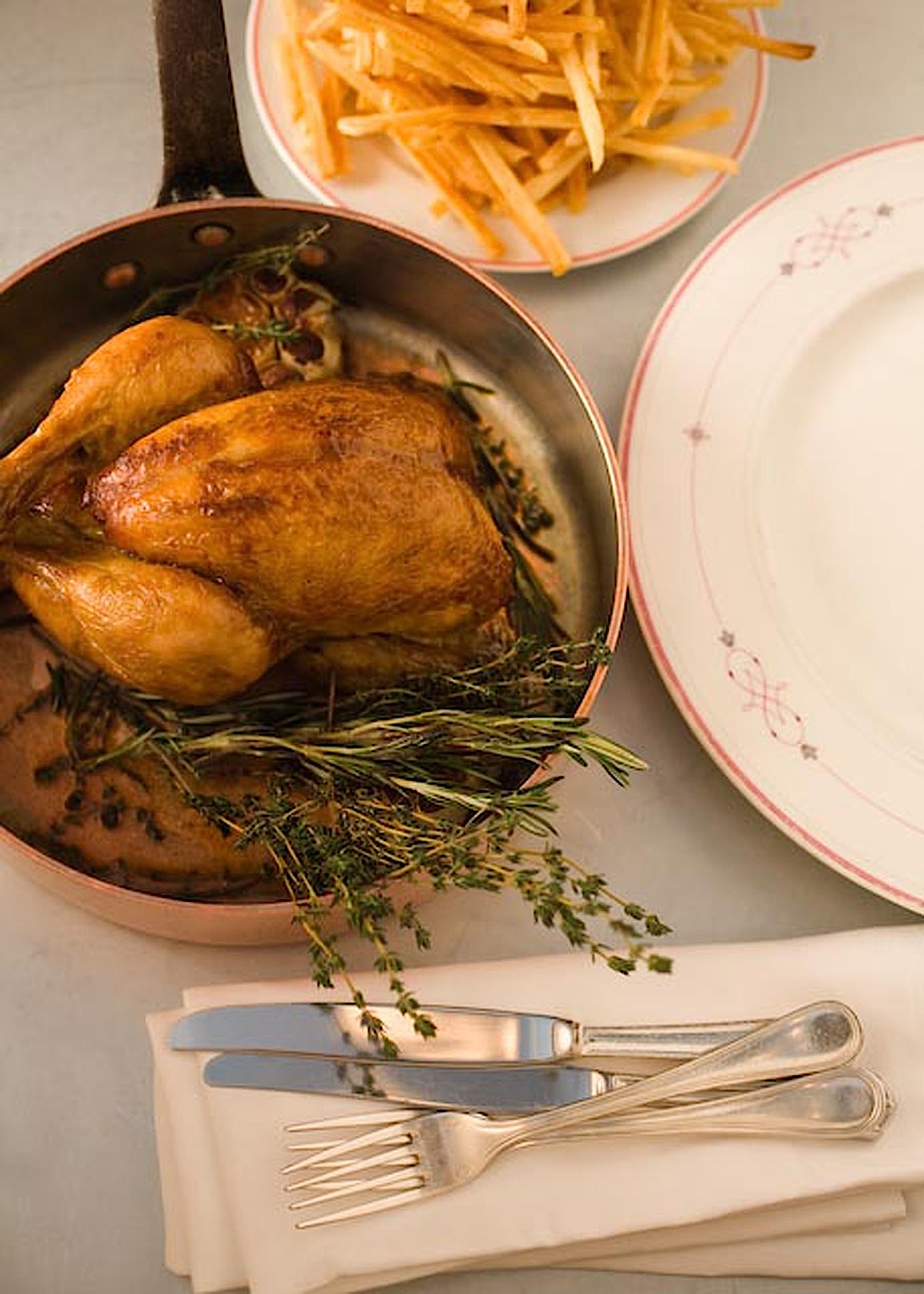 not to miss
is the twice-baked
upside-down Comte cheese soufflé. I
remember when every French
restaurant in town served a cheese soufflé
and charged absurd
prices or surcharges for an amalgam of a few eggs
and shreds of Swiss
cheese; Benoit's soufflé is a marvel,
decidedly rich, luxurious,
and velvety, hot on the first bite, heaven on the
second, and even at
$14, it's worth it.
not to miss
is the twice-baked
upside-down Comte cheese soufflé. I
remember when every French
restaurant in town served a cheese soufflé
and charged absurd
prices or surcharges for an amalgam of a few eggs
and shreds of Swiss
cheese; Benoit's soufflé is a marvel,
decidedly rich, luxurious,
and velvety, hot on the first bite, heaven on the
second, and even at
$14, it's worth it.
One of the best
bargains in NYC is Benoit's choice of thee hors
oeuvres for $15 or
five for $16, with just enough for two to taste.
Main courses are kept to
a dozen or so, with
hearty winter items like calf's liver with sweet
onions and Lyonnaise
potatoes, filet mignon with a bracing peppercorn
sauce, steamed loup
de mer with lemon and
lavender, and a textbook perfect roast chicken for
two, which is
brought to the table for your inspections and
delectation, its
aromas of fat and garlic and rosemary
wafting across the table.
You swoon, the appetite races, and you count the
moments while the
waiter plates the pieces of chicken (two people
might well take some
home), then plunks down a generous portion of
fabulous frites,
which you will definitely not take
home because you will
demolish every last one of them.
My one disappointment with the
menu is the removal
of the quenelles of pike with Nantua sauce, once a
famous dish at La
Côte
Basque and originally on the menu at Benoit, now,
sadly, gone. (Psst!
They still make quenelles at
the
new Millesime
and Lyon
Bouchon Moderne,
both
of
which
I
shall
be
writing
about
soon.)
Desserts have a century
or so of history and
favor behind them, and Benoit does them all with
respect for their
lineage, from a succulently rummy baba
au
rhum to a crisp tarte Tatin
for two, along with light, puffy profiteroles and
a little sauce pot of
hot dark chocolate.
The Paris Benoit
puffs along with a very
similar menu, though, given the strength of the
Euro, prices are much
higher over there. And while I am no fan of
cloning originals, I
wouldn't mind there being a Benoit in every city
in America, if only to
remind people how enduring the vivacity and
honesty of a good bistro
truly is.
Benoit
is
open
daily
for
lunch
and
dinner.
Benoit
also
offers
a
prix-fixe
lunch
menu
for
2
courses
for
$22 and 3 courses for $28; prix-fixe
dinner menu from 5:30 pm to 6:30pm with 2
courses for
$28 and 3 for $38. A bar menu is served daily
until midnight.
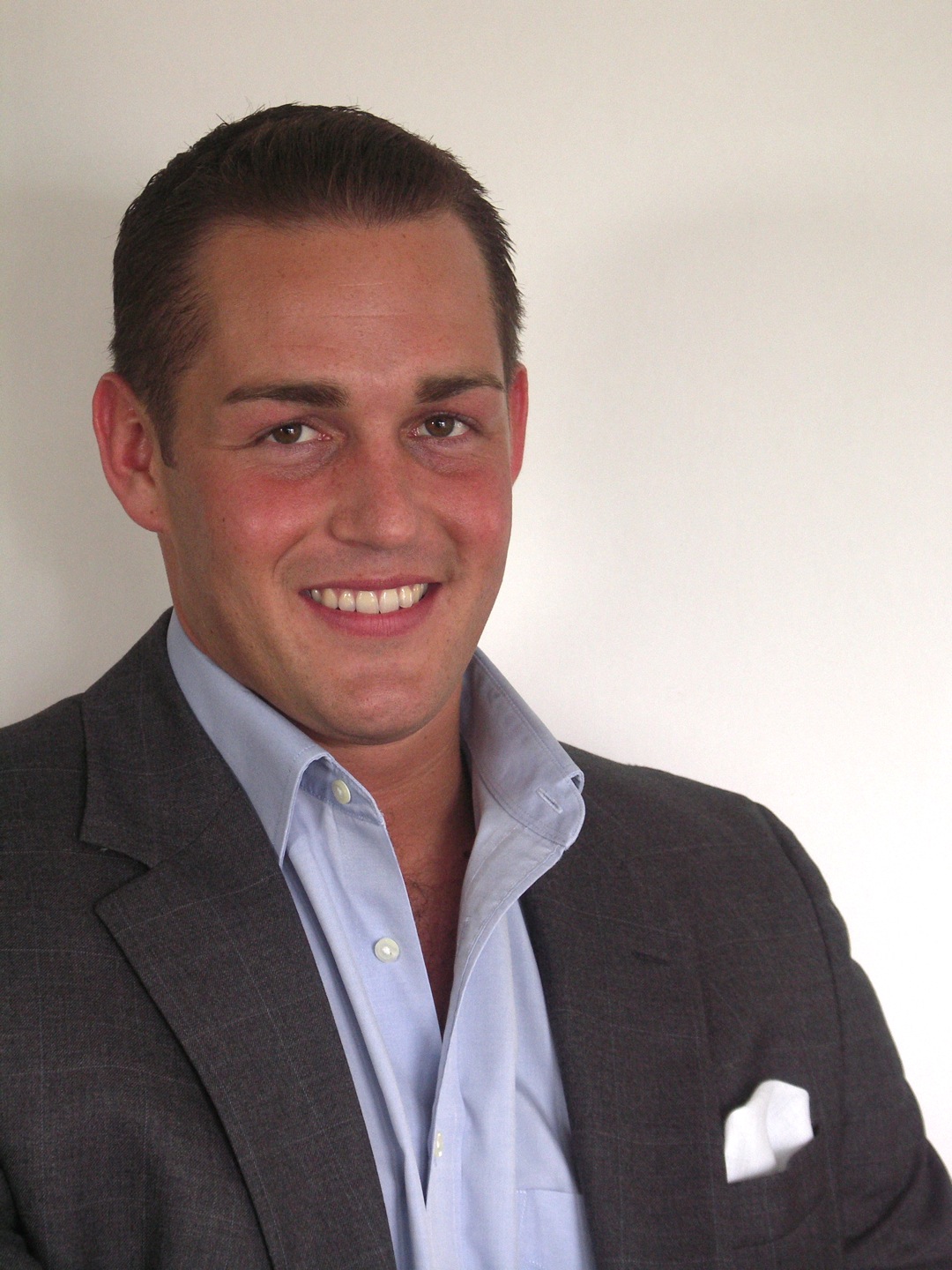
MAN ABOUT TOWN
by
Christopher Mariani
BENJAMIN STEAKHOUSE WHITE PLAINS
610 West Hartsdale Avenue
White Plains, NY
914-428-6868

Were
you
to ask me where to find a great
steak in Westchester County, NY, I would start
by saying there
are
only a
handful of restaurants worth a drive--Nick Vuli’s Flames
Steakhouse in
Briar Cliff
Manor, David Ghatanfard’s Tutta
Bella
Trattoria in Scarsdale and Port
Chester’s The
Willett
House. Beyond these
three, Westchester lacks
quality
steakhouses. So when I heard NYC's Benjamin Steakhouse
was coming up to
White
Plains (about a 45-minute drive from Manhattan),
I must say I was intrigued. And
after dining at Benjamin this past week, I am pleased
to say, my small
list of
great steak houses is beginning to grow.
Owner
Benjamin
Prelvukaj started his career in Brooklyn at the
legendary Peter Luger’s
steak
house, where he clearly honed his skills as a
restaurateur and
developed a keen
eye for obtaining the best beef available. Benjamin
opened his first
namesake
restaurant in Manhattan, located on East 41st,
between
Madison
and
Park
Avenue,
and,
just
recently,
in
Westchester's
most
dynamic
city,
White
Plains,
taking
over the
space
previously occupied by Mighty Joe Young’s. While
I
dined
at
Benjamin,
it
was
evident that Prelvukaj and cast have already found
their groove,
serving some
of the best USDA Prime steaks I’ve tasted in a long
time, comparable
to
those
found at Michael Lomanaco’s Porter
House and the
famous Ben
Benson’s in
NYC.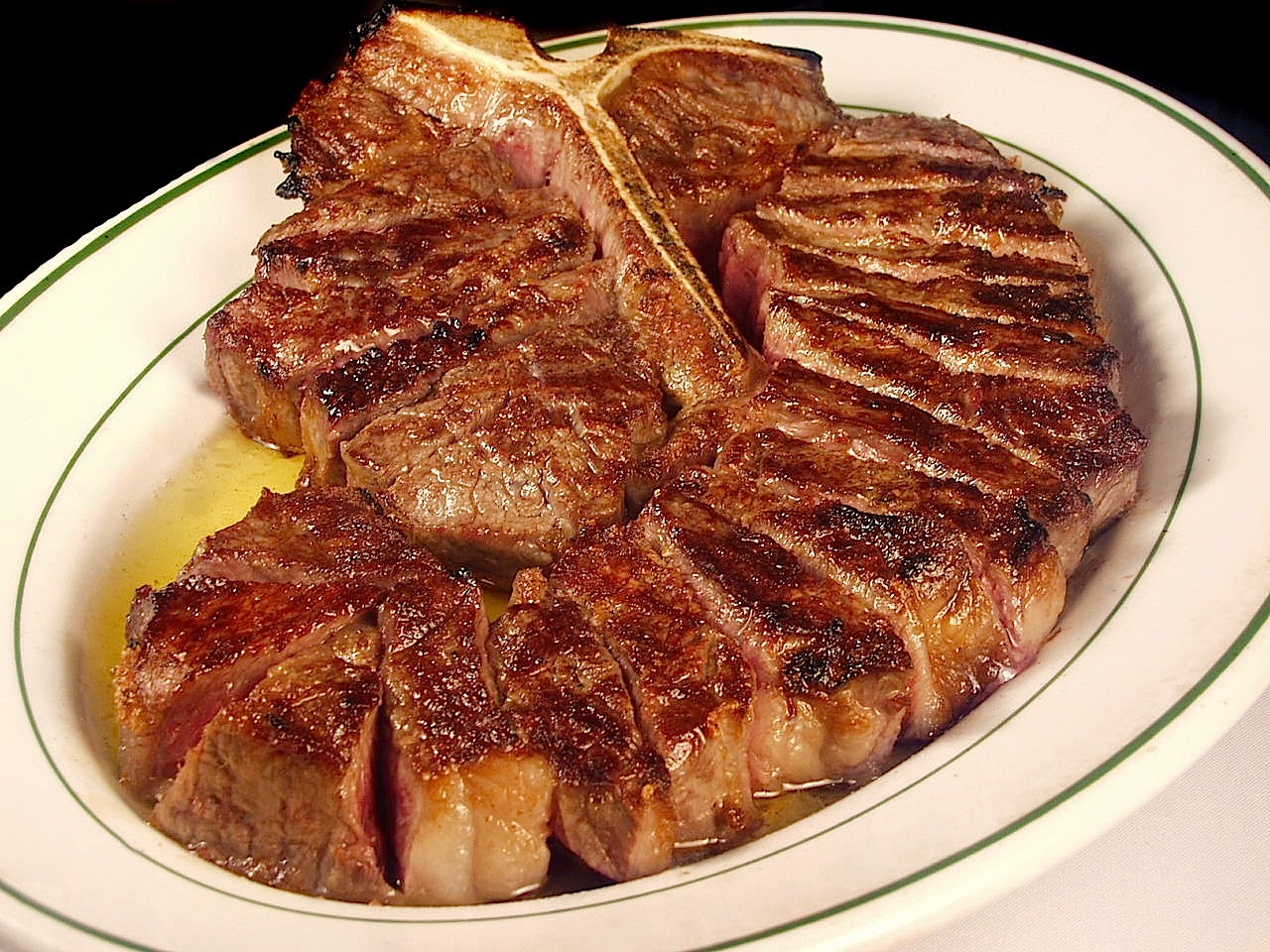
Benjamin
has
a
typical
steak
house
design:
white
walls
and
ceilings
with
a
thin
wood
trim,
dark brown
leather
chairs, polished wood floors, and a grand
fireplace guests
can
dine
beside while receiving terrific service by an all-male
wait staff
dressed in white
shirts and black bow ties. Upon
entering
the restaurant, all guests are greeted by Benjamin’s
gorgeous hostess, Linda
Liolla,
who
was
recently chosen as Esquire’s
hostess
of
the
week.
Sitting directly in front of the fireplace, I
enjoyed a
perfectly made
Manhattan cocktail. For starters, the crab cakes come
two on
a plate, made with large
chunks of lump crab meat; shrimp cocktail, served with
either
four or
six shrimp, sided by a house-made cocktail sauce
spiked with
horseradish
and
spice; a lush strip of juicy Canadian bacon; and a
creamy lobster
bisque soup,
full of flavor and generous in size, but lacking
lobster chunks, any if
at all.
In between courses, I
ordered a
nice
bottle of Carneros pinot noir wine from 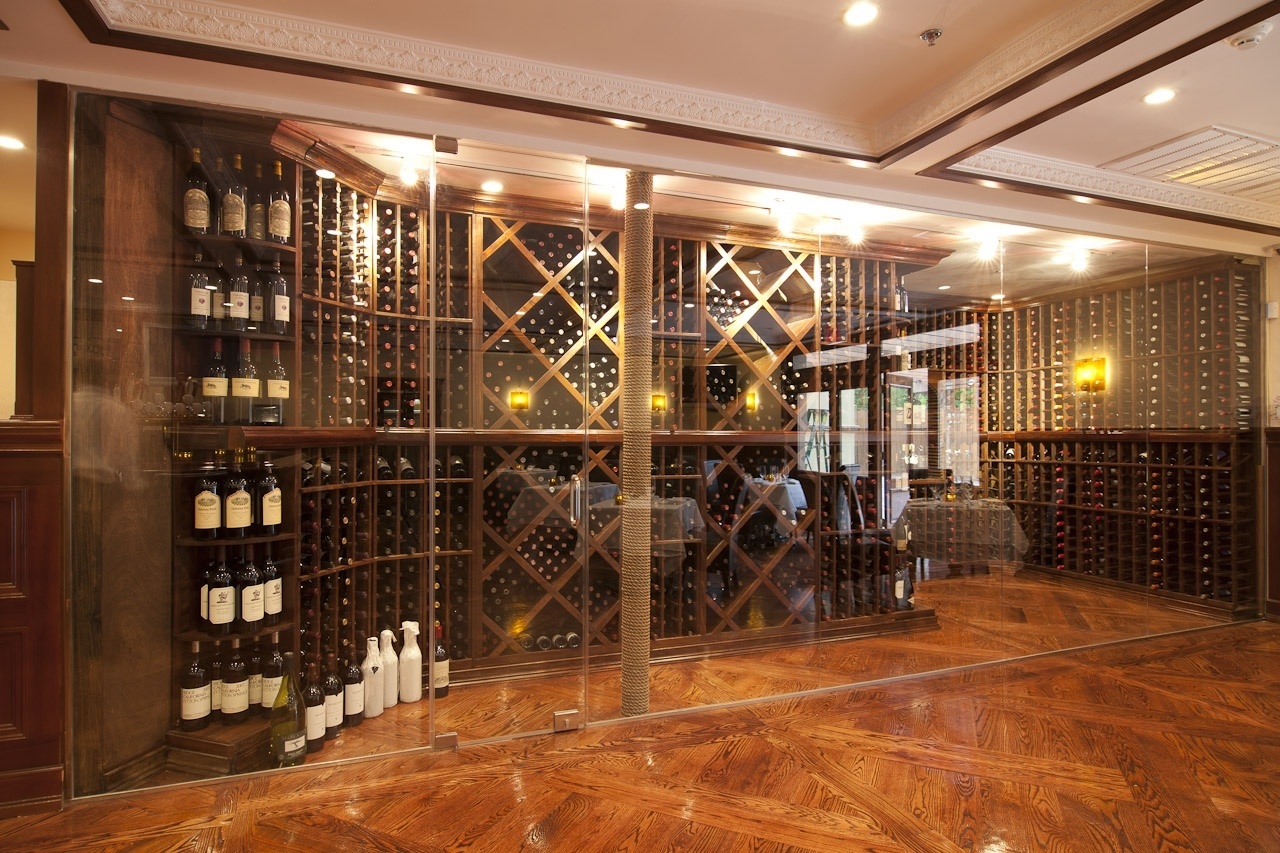 Benjamin’s impressive wine
list, offering
varietals
from almost every corner of the earth, with prices
that go from
affordable
to very expensive. The
wines themselves
are stored within an elegant glass wine room (left)
directly across
from the
restaurant’s bustling bar, by designer Emilio
Escaladas.
Benjamin’s impressive wine
list, offering
varietals
from almost every corner of the earth, with prices
that go from
affordable
to very expensive. The
wines themselves
are stored within an elegant glass wine room (left)
directly across
from the
restaurant’s bustling bar, by designer Emilio
Escaladas.
Executive
chef
Arturo
McLeod
has
been
with
Benjamin
for
many
years
and
the
two
work
in a harmonious tandem, as the front and back of
the
house run as efficiently as a steak house needs
to be.
The
steaks
come
from Strassburger
Meats and are the obvious highlight
of
Benjamin’s menu, thick, well-fatted cuts of USDA Prime
beef. We ordered the
porterhouse
for two (above),
which , in
the style set long ago by Luger's, came on a sizzling
hot oval plate,
the meat seared just
right on
the outside and medium-rare on the inside. For
sides, we shared the thick crispy steak fries,
an
order of the creamed
spinach (a bit salty that night), and a plate of
sautéed
mushrooms mixed
with chopped
garlic, all large enough for a party of four.
For
dessert, the tiramisù and chocolate cake were
accompanied by
whipped cream; both stand an imposing three to four
inches
tall.
Benjamin
Steakhouse may be the new guy on the block here in
Westchester County,
but from what I saw of the packed house on a Tuesday
night, it's
quickly becoming a favorite among locals and those who
have heard about
a great new steak house north of Manhattan.
``````````````````````````````````````````````````````````````````````````
ARGENTINE ADVENTURE
by Brian Freedman
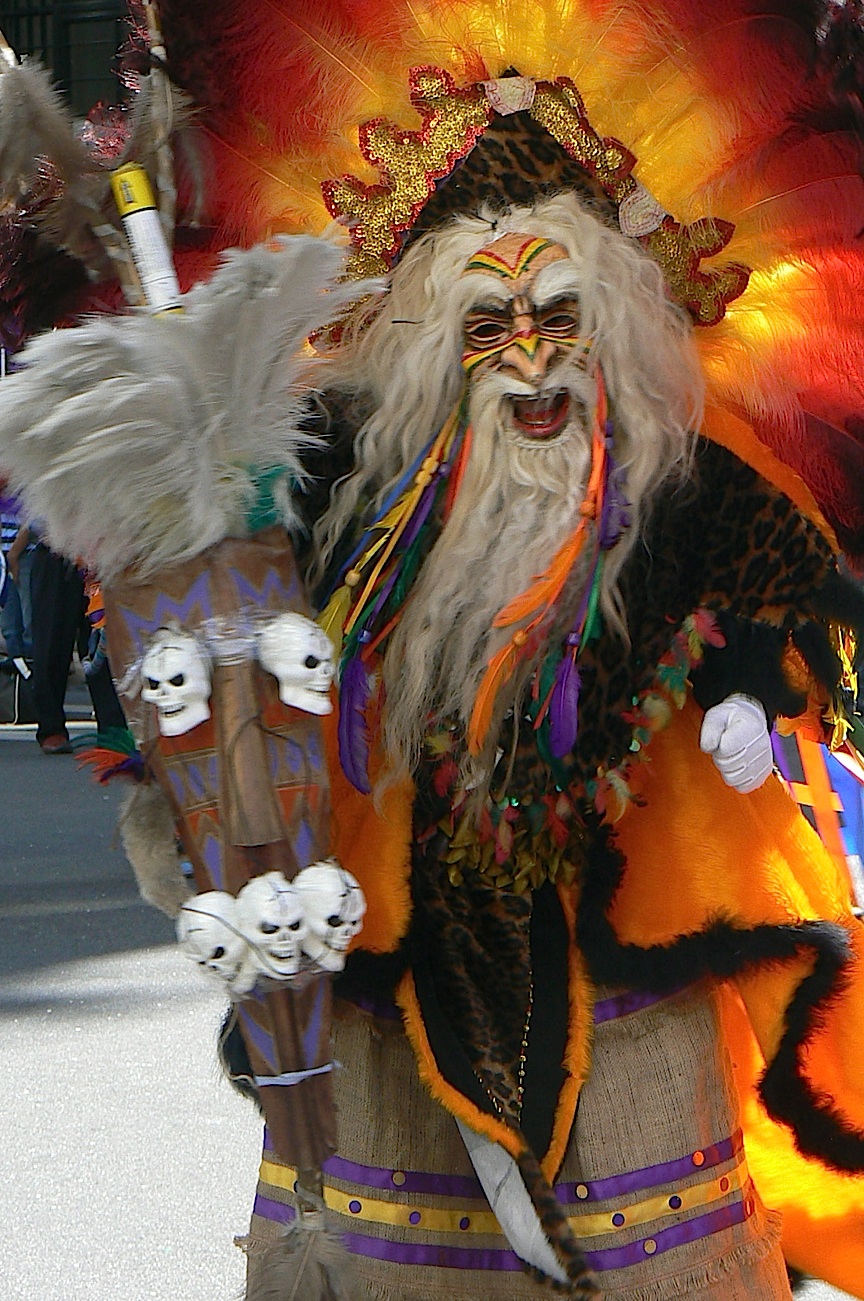 Walking
toward the old San Telmo neighborhood of Buenos
Aires with Felipe
Carvallo, of
the excellent wine producer Valle de la Puerta,
we heard trumpets and
drums in the
distance. Then,
with no warning except the crush of people massed
ahead of us, we
walked
straight into the Bolivian festival (left), a
parade of dozens
of groups
of Bolivian dancers and musicians whose exuberant
costumes and
performances
could rival the Macys Thanksgiving Day Parade.
Walking
toward the old San Telmo neighborhood of Buenos
Aires with Felipe
Carvallo, of
the excellent wine producer Valle de la Puerta,
we heard trumpets and
drums in the
distance. Then,
with no warning except the crush of people massed
ahead of us, we
walked
straight into the Bolivian festival (left), a
parade of dozens
of groups
of Bolivian dancers and musicians whose exuberant
costumes and
performances
could rival the Macys Thanksgiving Day Parade.
Turns
out
that
this
was
a
perfect
introduction
to
Argentina, which I toured this
past October on a trip sponsored by Wines of
Argentina. Because no
matter what you’ve heard about this huge country, it
is invariably more than that: More
diverse, more
exciting, more downright tasty. (You will most likely
return home with
serious
addictions to Argentine beef, dulce
de leche, and, unexpectedly,
Fernet-Branca, not to mention the wines, of course.)
Over
ten days, we tasted more wines than I could count.
But what struck me most about them was not just the
overall quality,
which, as
any fan of the wines of Argentina knows, is typically
quite high, as
well as
fairly priced, but the sheer range of styles and grape
varieties being
produced. Indeed, though generous, affordable malbec
has been the
catalyst for
Argentina’s skyrocketing reputation on this side of
the equator, it is
far from
the only variety with which Argentina stands to move
forward to bolster
its name internationally. From concentrated,
expressively
idiosyncratic malbecs sourced
from single vineyards in the often higher altitudes to
bottlings that
lean on
varieties most of us don’t associate with Argentina,
this is a country
whose
future is not only bright, but far more varied than
most consumers
realize.
As
I’ve
pointed
out
before,
one
of
the
great
advantages of wine travel is
having
the chance not only to taste bottlings not yet
being exported but
to
experience them in the context of the regions that
produce them and
alongside
the foods that marry best with them. As such, our
experiences in Buenos
AIres
(where our tastings focused on the wines of the
north), Patagonia,
Mendoza, and
San Juan provided a crystal-clear pastiche of exactly
how much
potential and
excitement Argentina promises in the coming years and
decades.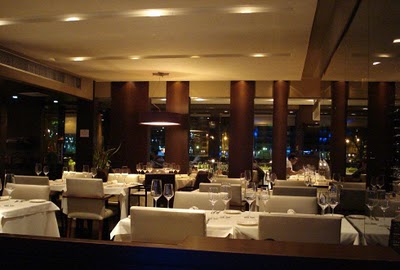
Buenos
Aires
Simply
put, Buenos Aires is one of the most vibrant,
cosmopolitan cities I’ve
ever
spent time in. It’s a sprawling tangle of
neighborhoods, markets,
restaurants,
cultural influences, monumental grandeur, edgier
neighborhoods, and
everything
else you’d hope for in one of the great capitals of
the world. As far
as
restaurants go, I’d include two Buenos Aires
destinations as among the
top five
meals I’ve experienced in the past year.
Chila (right)
in the upscale Puerto Madero neighborhood, boasts an
astounding menu
that finds
the perfect middle ground between Argentina and
France, as rendered by
Chef
Soledad Nardelli. My appetizer of goat's sweetbreads
with bacon, a
miraculously
subtle cabbage cream, and a perfectly delicate
vegetable broth started
off a
meal of astounding depth and variety. And if the
sweetbreads peddled in
more
delicate flavors, then the red deer loin found its
footing on the more
explosive side of the spectrum, its accompanying
cauliflower puree a
smart foil
for the compressed sweet potato and apple and the
sweet-tangy marron
glacé. Our
table overlooked the river and the high-rises
sprouting on the opposite
bank,
and the entirety of the experience was utterly
transporting.
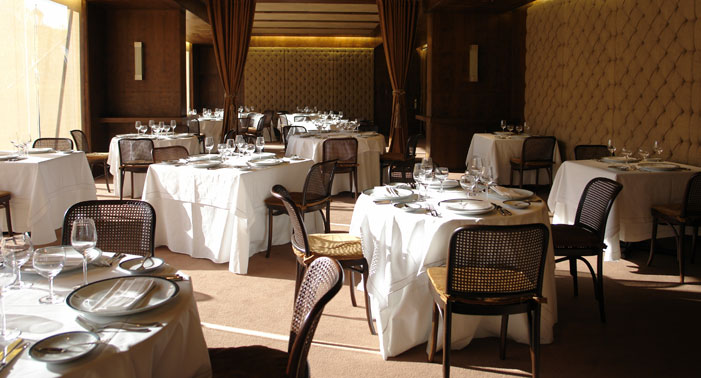 Tomo1 (left)
in the Panamericano Buenos Aires Hotel by the Obelisco
(and opposite
the NH
Tango
Hotel where we stayed while in the city), was
just as
avant-garde. There,
we were treated to a multi-course tasting menu that
highlighted exactly
why the
food of sister chefs Ada and Ebe Concaro and executive
chef Federico
Fialayre
is generating so much buzz. Here, a dish like the
langoustines with
crunchy pancetta and
strawberries
in vinegar showed just how exciting Porteño
cuisine
is these days. Wine service (which, for our meal,
focused on the
excellent
wines of Luigi Bosca) and the overall ambience at both
restaurants,
alongside
such stunning food, will easily warrant Michelin stars
if the guide
ever heads to BA.
Tomo1 (left)
in the Panamericano Buenos Aires Hotel by the Obelisco
(and opposite
the NH
Tango
Hotel where we stayed while in the city), was
just as
avant-garde. There,
we were treated to a multi-course tasting menu that
highlighted exactly
why the
food of sister chefs Ada and Ebe Concaro and executive
chef Federico
Fialayre
is generating so much buzz. Here, a dish like the
langoustines with
crunchy pancetta and
strawberries
in vinegar showed just how exciting Porteño
cuisine
is these days. Wine service (which, for our meal,
focused on the
excellent
wines of Luigi Bosca) and the overall ambience at both
restaurants,
alongside
such stunning food, will easily warrant Michelin stars
if the guide
ever heads to BA.
During
our
brief
stay
in
the
city,
we
focused
mainly on the wines of the north,
from
regions like Salta and Cafayate. Expressive bottlings
made from the
aromatic
torrontes grape variety, like the concentrated apricot
and herb-tinged
2010
Laborum from Bodegas El Porvenir,
and the
more orange-, peppercorn-, and
cantaloupe-driven 2010 from Valle de la Puerta,
really stood
out. On the more
powerful end of the torrontes spectrum was the Bodegas Etchart
Gran Linaje
2010, which demonstrated an almost Condrieu-like
grilled peach and
white flower
aroma.
The
north
is
not
only
white
wine
country,
however.
Bodegas Etchart’s Cafayate
Malbec Reserva 2009 showed fresh black raspberry,
meat, and a very
appealing
minerality. Bodegas El Porvenir’s Amauta 2006, a
malbec, cabernet
sauvignon,
and syrah blend, sang with wild strawberries,
blackberries, and
chocolate, as
well as a balsamic note that lent both depth and
freshness. Bonarda
also does
well in the north, as demonstrated by a number of
wines we tasted from
La
Puerta Alta.
Patagonia
Few
names on the map evoke images as remote and exotic as
Patagonia. And  while we
stayed in the wine-producing regions toward the north
of it--still a
distance
from the penguins of places like Ushuaia--this was
still as wonderfully
close
to the end of the earth as I’ve ever come. It reminded
me, in many
ways, of
what I imagine some sort of South American Montana to
look like: The
biggest
sky I’ve ever swept my eyes across, and endless vistas
of vineyards,
unplanted
land, and rivers. Here we stayed at the Valle
Perdido,
(above, right) an
unexpectedly modern,
beautifully constructed resort whose name, meaning
“Lost Valley,” is
as close to truth in advertising as I’ve ever
experienced. From my
room’s porch
I had views, stretching out further than I could see,
of a purple and
orange
sunset of staggering, humbling brilliance.
while we
stayed in the wine-producing regions toward the north
of it--still a
distance
from the penguins of places like Ushuaia--this was
still as wonderfully
close
to the end of the earth as I’ve ever come. It reminded
me, in many
ways, of
what I imagine some sort of South American Montana to
look like: The
biggest
sky I’ve ever swept my eyes across, and endless vistas
of vineyards,
unplanted
land, and rivers. Here we stayed at the Valle
Perdido,
(above, right) an
unexpectedly modern,
beautifully constructed resort whose name, meaning
“Lost Valley,” is
as close to truth in advertising as I’ve ever
experienced. From my
room’s porch
I had views, stretching out further than I could see,
of a purple and
orange
sunset of staggering, humbling brilliance.
Wine-wise,
this
is
a
region
with
serious
potential,
and
depending on the producer, one
grape or style or another will convince you that, yes,
this
is what will put Patagonia on the international wine
map. At
the wonderfully named Bodega del Fin del
Mundo, I was
convinced that Patagonia’s
future lay in sparkling wine. Their Extra Brut NV
smelled of
whole-wheat bread
with strawberry jam and tasted of cherries and
minerals. Then, after
sampling
the concentrated, endlessly complex malbecs and pinot
noirs at NQN,
we thought
that these varieties would help make Patagonia’s name.
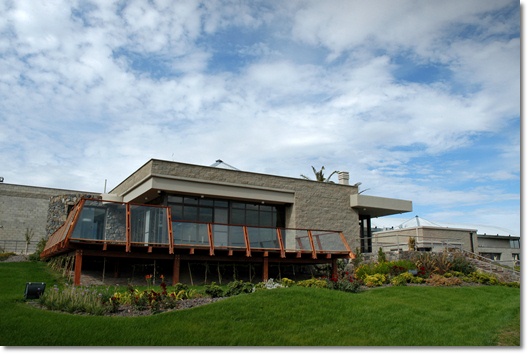 Their Pinot Noir Finca
La Papay 2010, with its spiced meat, cherries, and
chanterelles, was a
muscular, age-worthy red whose hint of flowers on the
finish lent a
beautiful
sense of elegance. At Humberto Canale,
it
was
merlot
and
cabernet
sauvignon
that
won
me over. At Familia Schroeder,
the Saurus
Pinot Noir Tardío 2008
charmed (yes, a late-harvest pinot!). We were also
treated to a
delicious lunch
here at the Saurus
Winery Restaurant (left), the huge glass windows
overlooking the
Patagonian expanse beyond; and the food was every bit
as transfixing as
the
view.
Their Pinot Noir Finca
La Papay 2010, with its spiced meat, cherries, and
chanterelles, was a
muscular, age-worthy red whose hint of flowers on the
finish lent a
beautiful
sense of elegance. At Humberto Canale,
it
was
merlot
and
cabernet
sauvignon
that
won
me over. At Familia Schroeder,
the Saurus
Pinot Noir Tardío 2008
charmed (yes, a late-harvest pinot!). We were also
treated to a
delicious lunch
here at the Saurus
Winery Restaurant (left), the huge glass windows
overlooking the
Patagonian expanse beyond; and the food was every bit
as transfixing as
the
view.
The
moral
of
our
trip
to
Patagonia
was
that
it conjures images of natural
wonders, but its vinous ones have the potential to be
every bit as
stunning.
Mendoza
and
San
Juan
Mendoza
is the most famous wine region in Argentina, and
deservedly so: It is
home to
some of the most remarkable malbecs on the planet,
though to assume
that that
great red grape is the extent of what Mendoza is
capable of would be to
miss
the point entirely. Trailblazers
like
Familia
Zuccardi, Lagarde,
and Clos de los
Siete are leading the
way,
alongside other standout producers like Piattelli,
Mendel, Dominio
del Plata,
Diamandes, 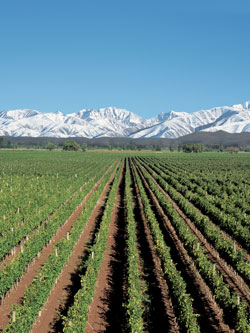 Trivento,
Serrera,
Clos de
Chacras, Catena (below, right), Casarena,
and Doña
Paula, as well as too many others to list
here. (NB:
Tasting notes from all the
producers will be posted on the blog
www.UncorkLife.com by
www.WineChateau.com
in the coming weeks and months.) Tempranillo, petite
verdot, syrah,
bonarda,
semillon, and many more grape varieties are being
given utterly
gorgeous
expression in this region in the shadow of the Andes.
Trivento,
Serrera,
Clos de
Chacras, Catena (below, right), Casarena,
and Doña
Paula, as well as too many others to list
here. (NB:
Tasting notes from all the
producers will be posted on the blog
www.UncorkLife.com by
www.WineChateau.com
in the coming weeks and months.) Tempranillo, petite
verdot, syrah,
bonarda,
semillon, and many more grape varieties are being
given utterly
gorgeous
expression in this region in the shadow of the Andes.
North
of
Mendoza,
in
San
Juan,
less-well-known
producers
are
starting to make
their
mark. The supremely soulful wines from Merced del Estero,
which is
right now
exporting in very limited quantities, are poised to
make a serious
contribution
to the reputation of this often-overlooked part of the
country. Their
cabernet
and torrontes, as well as their malbec, are
particularly lovely. And Casa
Montes (no relation to the Chilean producer
of the same name) is
home to one of
the top petite verdots (the Don Baltazar 2008
bottling) I tasted in
Argentina.
For
all
its
great
wines,
Mendoza
is
a
fantastic
destination in its own right, a
city that, with its leafy boulevards, endlessly green
parks, and
sidewalk
cafés, reminded me, in more than a few ways, of
Paris and
Philadelphia.
We
stayed
at
the Diplomatic Hotel,
a 5-star
beauty whose grand, yet not
overwrought, lobby sets the perfect tone. My room
looked out over the
mountains, and provided breathtaking views of the
shifting colors of
the
sunrises and sunsets. And across the street from the
hotel is La Barra,
a
carnivore’s Everest that is home to steaks and other
meaty goodies that
will
likely be your base of comparison for all other flesh
moving forward.
My
last
night
in
Mendoza
(my
last
night
in
the country, in fact), I met Carlos
Tizio Mayer, general manager of Clos de los Siete, for
an asado at
La Barra.
Over the course of three hours, we enjoyed everything
from chinchulín
(smoky,
earthy grilled intestines) to ribs to an inches-thick
steak that had
been
slowly grilled over the glowing embers of a fire  by the owner
himself. Paired
with the excellent, intensely expressive Clos de los
Siete, and enjoyed
in the
company of a virtual United Nations of travelers
(Germany, Ireland,
Italy,
England, the United States, and more were
represented), this was, in
hindsight,
the only appropriate way to end my trip to one of the
most exciting,
surprising, and eye-opening countries I’ve visited.
by the owner
himself. Paired
with the excellent, intensely expressive Clos de los
Siete, and enjoyed
in the
company of a virtual United Nations of travelers
(Germany, Ireland,
Italy,
England, the United States, and more were
represented), this was, in
hindsight,
the only appropriate way to end my trip to one of the
most exciting,
surprising, and eye-opening countries I’ve visited.
I
also
strongly
recommend Francesco Barbera
Ristorante, an
Italian restaurant
helmed by the indefatigable, endlessly charming chef
María
Teresa Corradini de
Barbera (left).
Settle into a
table on the open-air patio, order more wine than you
think you’ll need, and soak it all up with, among
other Italian
standouts, what
I’m comfortable calling one of the best lasagnas in
the world.
All
told, Argentina, for all the buzz and acclaim its
wines have generated,
is a
supremely rewarding, must-visit destination whether
you’re a wine lover
or not. Nearly all of the producers I
spoke with and visited made mention of their desire
not to fall into
the trap
of being perceived as a one-varietal country. That
sense of awareness,
as well
as their ability to produce world-class wines from any
number of grape
varieties and in the full range of terroirs afforded
by Argentina’s
geography
and landscape, promise a very bright future indeed for
this country
whose wine
story is just starting to be told in its entirety.
Brian Freedman is a
food,
wine, and travel writer, wine consultant, and speaker.
He writes the
blog UncorkLife.com for Wine Chateau, is
restaurant critic for Philadelphia
Weekly, South Jersey
Magazine, and Suburban
Life
Magazine, wine columnist for Affluent Magazine, and contributes to
a number of other
publications, including Philadelphia
Style Magazine.
~~~~~~~~~~~~~~~~~~~~~~~~~~~~~~~~~

RESTAURANT
REVIEWS
WE
NEVER
FINISHED
READING
“My wife, Michele,
had a funny thing happen before our first visit to
Claddagh Irish Pub
in
Lyndhurst's Legacy Village. She stepped outside for a
smoke, and met
another
smoker who was also about to make her first visit to
Claddagh. After
striking
up a conversation, the other smoker remarked: `Isn't
Irish food
supposed to be
crappy?’"--Bob Migra, “Claddagh
Irish Pub in
Lyndhurst offers a hint of the Emerald Isle with a
strong American
accent,” The Cleveland Plain
Dealer (11/23)
MORE REASONS TO STAY OUT
OF NYC
“My reaction is, ‘God, I've got to stay away
from
those hot dogs and nuts on the street corner and
the ice cream!’ Like
those
trucks, I've never seen that before — trucks of
ice cream. You have to
stop and
eat! I couldn't control myself, so [in] New York
[I] put on like 10
pounds and
then I'm pregnant with Kanye's baby.” —Kim
Kardashian explaining how
rumors
she’s pregnant by Kanye West are the result of
eating NYC street food.
``````````````````````
QUICK BYTES
✉ Guidelines for submissions: QUICK BYTES publishes only events, special dinners, etc, open to the public, not restaurant openings or personnel changes. When submitting please send the most pertinent info, incl. tel # and site, in one short paragraph as simple e-mail text, WITH DATE LISTED FIRST, as below. Thanks. John Mariani
* On Jan. 15 & 16 in Sonoma
County, CA the Wine Road hosts
its 19th annual
“Winter Wineland” event, where wine
enthusiasts can wander through the striking landscape
and picturesque
towns of
Northern Sonoma meeting winemakers, tasting
limited-production wines,
viewing
fine art, and learning about the art of winemaking.
Advance
tickets $45 for
both days, $35 for Sunday, and $5 for designated
drivers and incl.
tastings
and viewings at all the participating wineries.www.wineroad.com
, or
call 1-800-723-6336.
* On Jan. 16 in Chicago, Cityscape Bar will host a viewing party for the 68th Annual Golden Globe Awards. Patrons will enjoy themed cocktails for $6 each including: The Red Carpet and The Envelope Please. Free Admission. Visit cityscapebar.com .
* On
Jan. 18, Quartino
Ristorante
in Chicago
will host Jason
Sharko of Castello Banfi vineyard
for a reception and five-course dinner created by
Quartino Executive
Chef John
Coletta. $49 pp. Call 312-698-5000 or quartinochicago.com.
* On Jan. 22, Persimmon Creek Vineyards in Clayton, GA, will host a Saint Vincent's Day Celebration wine dinner. Saint Vincent is the patron saint of vine growers in Spain and France. A 5-course dinner prepared by an appropriately named chef (Vincent Scafiti) will be served with Persimmon Creek Vineyards estate grown wines. $95pp. 706-212-7380, persimmoncreekwine.com.
* On Jan. 23
in NYC, COCHON
555 kicks off its 10-city
national culinary competition promoting heritage breed
pigs and breed
diversity. The tasting event will challenge 5
chefs, incl. Brad
Farmerie of The Public, Peter Hoffman of Savoy, Bill
Telepan of Telepan
Restaurant, George Mendes of Aldea and Sean Rembold of
Marlow &
Sons, to
prepare a menu created from 5 heritage breed pigs,
with
wines from 5
different small wineries, incl. Scholium Project,
Alysian Winery, Elk
Cove
Vineyards, Copain Wine Cellars and Failla Wines, as
well as the
opportunity to
help select the “King or Queen of Porc.” Guests
will
be
treated to whole pig breakdown demos. $125pp; www.Cochon555.com
* From
Jan. 28 – Jan. 30, in Eugene,
OR,
the 6th annual Oregon Truffle Festival
celebrates Oregon's native truffles with chefs,
scientists, truffle
dogs and
artists for a weekend. Weekend
Experiences range from $500 - $1,000. Call
541-913-3841.
* On Jan. 29 & 30, the Greater Boston Food Bank presents "Super Hunger Brunch." The city’s top restaurants, including Ming Tsai’s Blue Ginger, Jody Adams’ Rialto and Tony Maws’ Craigie on Main, donate 100% of the proceeds from $25, $25 and $50 prix-fixe brunches to the Food Bank’s Super Hunger Month fundraising initiative. www.superhungermonth.org. Call 617.427.5200.
``````````````````````````````````````````````````````````````````````Everett Potter's Travel Report:

~~~~~~~~~~~~~~~~~~~~~~~~~~~~~~~~~~~~~~~~~~~~~~~~~~~~~~~~~~~~~~~~~~~~~~~~~~
Eating Las Vegas is the new on-line site for Virtual Gourmet contributor John A. Curtas., who since 1995 has been commenting on the Las Vegas food scene and reviewing restaurants for Nevada Public Radio. He is also the restaurant critic for KLAS TV, Channel 8 in Las Vegas, and his past reviews can be accessed at KNPR.org. Click on the logo below to go directly to his site.
~~~~~~~~~~~~~~~~~~~~~~~~~~~~~~~~~~~~~~~~~~~~~~~~~~~~~~~~~~~~~~~~~~~~~~~~~~~
Tennis Resorts Online: A Critical Guide to the World's Best Tennis Resorts and Tennis Camps, published by ROGER COX, who has spent more than two decades writing about tennis travel, including a 17-year stretch for Tennis magazine. He has also written for Arthur Frommer's Budget Travel, New York Magazine, Travel & Leisure, Esquire, Money, USTA Magazine, Men's Journal, and The Robb Report. He has authored two books-The World's Best Tennis Vacations (Stephen Greene Press/Viking Penguin, 1990) and The Best Places to Stay in the Rockies (Houghton Mifflin, 1992 & 1994), and the Melbourne (Australia) chapter to the Wall Street Journal Business Guide to Cities of the Pacific Rim (Fodor's Travel Guides, 1991). THIS WEEK:

The Family Travel Forum - A community for those who "Have Kids, Still Travel" and want to make family vacations more fun, less work and better value. FTF's travel and parenting features, including reviews of tropical and ski resorts, reunion destinations, attractions, holiday weekends, family festivals, cruises, and all kinds of vacation ideas should be the first port of call for family vacation planners. http://www.familytravelforum.com/index.html
ALL YOU NEED BEFORE YOU GO

nickonwine: An engaging, interactive wine column by Nick Passmore, Artisanal Editor, Four Seasons Magazine; Wine Columnist, BusinessWeek.com; nick@nickonwine.com; www.nickonwine.com.

~~~~~~~~~~~~~~~~~~~~~~~~~~~~~~~~~~~~~~~~~~~~~~~~~~~~~~~~~~~~~~~~~~~~~~~~~
MARIANI'S VIRTUAL GOURMET
NEWSLETTER is published weekly. Editor/Publisher: John
Mariani.
Contributing Writers: Christopher
Mariani, Robert Mariani,
John A. Curtas, Edward Brivio, Mort
Hochstein, Suzanne Wright, and
Brian Freedman. Contributing
Photographers: Galina Stepanoff-Dargery,
Bobby Pirillo. Technical
Advisor: Gerry
McLoughlin.
Any of John Mariani's
books below
may be ordered from amazon.com by clicking on the
cover image.
 My
newest book, written with my brother Robert
Mariani, is a memoir of our
years growing up in the My
newest book, written with my brother Robert
Mariani, is a memoir of our
years growing up in the For those of you who don't think of the Robert and I think you'll enjoy this very personal look at our --John Mariani |
 |
 |
 |
 |
 |
 |
© copyright John Mariani 2011.
